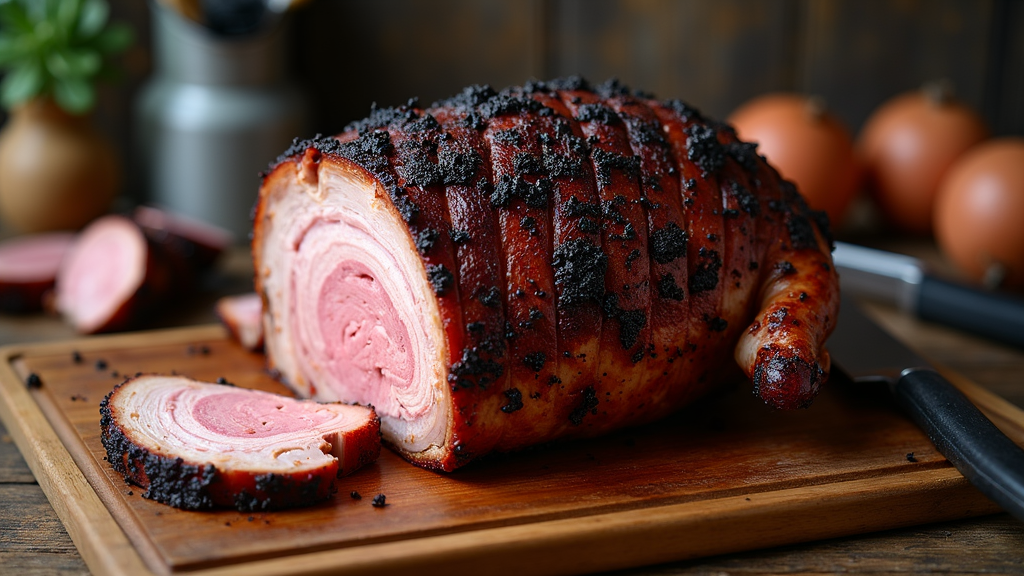
The Best Smoked Pork Shoulder: Tender, Flavor-Packed Every Time!
Walking into a backyard where someone’s been smoking pork shoulder for hours is a next-level cool experience. That savory, lightly sweet aroma drifting through the air makes my mouth water every single time. Smoked pork shoulder has been my go-to for big family get-togethers and laid-back summer weekends. The mix of smoky bark and juicy meat always impresses, and with a few handy tips, it’s surprisingly easy to get amazing results at home. There’s just something about watching the smoke curl up from the grill, knowing that something delicious is about to come your way.
I love smoked pork shoulder for a lot of reasons. It feeds a crowd without breaking the bank, doesn’t need fancy gear, and the leftovers are almost better than the main dish. Whether you’re new to smoking or have already dialed in your backyard BBQ skills, you’ll find this is a fun and tasty project. Plus, it’s hard to mess up once you know the basics. Smoking pork shoulder always makes me appreciate the simple things: good food, good company, and that slow pace of a weekend afternoon.
Why Smoked Pork Shoulder Is Worth Making
- No special pit needed. You can make this on any grill (charcoal, pellet, or gas) or a dedicated smoker. Even a basic kettle grill can handle the job—it’s just about steady low heat and good smoke.
- Rich, mellow flavor. Slow smoking brings out deep, savory notes, with a juicy inside and crispy, barky outside. The smoky crust, sometimes called the “bark,” is what sets smoked pork shoulder apart from anything roasted in the oven.
- Feeds a crowd. A pork shoulder easily serves a dozen people or more; it’s perfect for potlucks, parties, or family dinners. It’s a great way to fill bellies and make memories.
- Incredible leftovers. From pulled pork sandwiches to tacos or breakfast hash, the options just keep coming. There’s almost nothing you can’t do with leftover smoked pork!
Best of all, smoked pork shoulder is a forgiving cut—meaning you don’t have to stress over tiny temperature changes or a few extra minutes here and there. Relax, hang out, and let the smoke work its magic.
Essential Ingredients
Here’s what you need to make classic smoked pork shoulder at home:
- 1 whole pork shoulder (often called “Boston butt” or “picnic shoulder”), 6–8 pounds
- 1/4 cup yellow or Dijon mustard (as a binder)
- 1/2 cup BBQ rub (store-bought or homemade, see below)
- Wood chunks or chips (hickory, apple, cherry, or pecan all work nicely)
- Optional: Apple cider vinegar or juice for spritzing
Quick Homemade BBQ Rub
- 1/4 cup brown sugar
- 2 tablespoons paprika (smoked or regular)
- 1 tablespoon kosher salt
- 1 tablespoon black pepper
- 1 tablespoon garlic powder
- 1 tablespoon onion powder
- 1 teaspoon cayenne (or more to taste)
- 1 teaspoon mustard powder
If you have leftover rub, sprinkle it over roasted vegetables or use it to season grilled chicken for a flavor-packed twist.
How To Smoke Pork Shoulder
1. Choose and Prep Your Pork Shoulder
Look for a bone-in pork shoulder with a nice fat cap on top. The fat keeps everything juicy while it cooks. Pat it dry with paper towels. Dry meat helps the rub stick well and the bark form nicely. Sometimes you’ll see a shoulder labeled as “Boston butt” in stores. Despite the funny name, this cut comes from the upper part of the front leg—not the rear!
2. Add Seasoning
Rub the whole shoulder with mustard first. This helps the seasoning stay put and also keeps things juicy. Coat the pork generously with your BBQ rub, fully covering all sides. Don’t forget to push some rub into any nooks or creases for even flavor. Let it sit for 20–30 minutes while your grill heats up; this quick rest helps the rub meld onto the meat.
3. Set Up Your Smoker or Grill
Preheat your smoker or grill to a steady 225–250°F (107–121°C) with indirect heat. Add your favorite wood to get the smoke rolling. I’m a fan of fruit woods like apple or cherry for a slightly sweet, mellow smoke that’s great with pork. If your grill is smaller, a few chunks or a foil packet of soaked chips do the trick. Make sure the grill is set up for indirect cooking; this keeps the heat gentle and prevents burning.
4. Smoke It Low and Slow
Place the pork shoulder fat-side up on the grill, and then close the lid. Aim for a steady cooking temp and let the smoke work its magic. This whole process usually takes about 1.5 to 2 hours per pound, so a 7-pound shoulder could take 10–14 hours. Remember, it’s not a sprint—it’s all about that slow rhythm. At around the 3–4 hour mark, I like to spritz the pork every hour or so with apple juice or diluted apple cider vinegar. This keeps the surface moist and builds flavor. If you want to really give a boost to your bark, try adding a splash of bourbon or maple syrup to your spray bottle for a unique note.
5. Wait for the Magic Number
Smoking pork shoulder is all about internal temperature. The target for perfect pulled pork is 195–205°F (90–96°C). I usually start checking with a meat thermometer around 185°F. When the probe slides in with almost no resistance, you know it’s done. If you don’t have a thermometer, the bone should wiggle easily, and the meat will pull apart without much effort. A little patience here pays off big in tenderness.
6. Rest Before Pulling
This is really important. Wrap the shoulder in foil or butcher paper and let it rest in a cooler (or your turned-off oven) for at least 1 hour. This gives all the juices time to redistribute, making every bite tender and moist. If you rush the resting time, the juices won’t settle and your pork will lose its juiciness. Some folks rest it even longer—up to two hours—especially if the cut is larger. During the rest period, keep the pork wrapped tightly to lock in that moisture and warmth.
7. Time To Pull and Serve
After the rest, shred the pork using two forks or your hands (with gloves if still very hot). Remove any big pieces of fat or bone as you go. Mix the meat with the flavorful bark, then taste and add more seasoning or a splash of BBQ sauce if you like. Some people enjoy mixing in some of the cooking juices for even more flavor.
Tasty Serving Ideas & Extras
- Serve on soft sandwich buns with slaw and pickles for classic pulled pork sandwiches.
- Load up tacos with pork, cilantro, onions, and a squeeze of lime.
- Mix leftovers into breakfast hash, stirfry, or top baked potatoes.
- Save the bone to give a boost to ultra-rich soups or stews later.
- Try using the pork as a topping for homemade pizza or mixing into macaroni and cheese for a next-level cool meal.
Pork Shoulder Smoking Tips & Variations
- If you want firmer slices instead of pulled pork, stop cooking at 180–185°F. Let the meat cool a little before slicing.
- Switch up the rub: Try adding chipotle powder, cumin, or coriander for something smoky and earthy. Or mix in some coffee grounds for a deep, savory twist.
- Wrap with foil or butcher paper once the bark is set (usually around an internal temp of 160°F) if you’re short on time. This helps push through the “stall” phase where temps don’t rise for a while, so you can speed things up if needed.
- Use a water pan in your smoker to keep air humidity up. This can keep the pork juicier and keep the surface from drying out.
- Prefer a drier bark? Skip the spritzing for a thicker crust, or smoke uncovered the whole way for extra crunch.
- Want to set free more flavor? Try finishing your pork under the broiler for a couple of minutes for an ultra-crisp bark.
Another trick for extra flavor: inject your pork shoulder with a mix of apple juice and spices before adding the rub. This can help keep things moist and build flavor from the inside out.
Frequently Asked Questions
Q: Can I smoke pork shoulder ahead of time and reheat it?
Absolutely. Smoked pork shoulder actually gets better after resting. Shred it, add a splash of broth or pan juices, and reheat gently in the oven covered with foil for juicy results. You can also vacuum seal leftovers and reheat them using a sous vide if you have one.
Q: Do I need to trim the fat cap?
I usually leave most of it on, but if there’s a really thick, hard layer (over ½-inch), trim it down a bit. You want some fat for moisture but not so much that it won’t render down.
Q: What if I don’t have a smoker?
You can still get great results using a charcoal or gas grill. Set it up for indirect heat and use a foil packet of soaked wood chips to add smoky flavor. Some folks even get eye-catching bark and flavor in the oven by using smoked salt or liquid smoke, though nothing matches real wood smoke.
Q: How do I tell if it’s done without a thermometer?
The pork will feel very tender and the bone (if there is one) should slide out easily. The meat will also pull apart with a gentle tug. A thermometer is still the most reliable way to check, though. Learning to pick up on these signs comes with experience—soon, you’ll be able to spot perfect doneness by sight and feel.
Q: Can I freeze smoked pork shoulder?
Definitely! Shred the pork, cool it completely, then pack it into freezer bags along with some juices. Reheat straight from the freezer for a handy weeknight meal.
Share Your Pork Shoulder Wins!
Give smoked pork shoulder a try and see how easy and delicious homemade BBQ can be. Share your results, your favorite wood combos, or your best leftover ideas. I always love hearing about new twists and backyard BBQ stories. Serve it up, enjoy, and savor every smoky, juicy bite! Whether you’re a first-timer or an old pro, smoked pork shoulder brings people together and fills your table with great food, laughter, and memories. So fire up the smoker, invite some friends, and let it rip!
